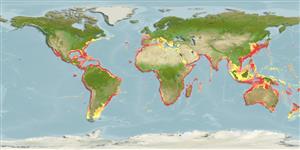Classification / Names
Common names from other countries
Main reference
Size / Weight / Age
Max length : 234 cm TL male/unsexed; (Ref. 26340); common length : 100.0 cm TL male/unsexed; (Ref. 26999); max. published weight: 5.0 kg (Ref. ); max. reported age: 15 years (Ref. 7142)
Length at first maturity
Lm 46.3, range 30 - 99 cm
Environment
Marine; brackish; benthopelagic; amphidromous (Ref. 51243); depth range 0 - 589 m (Ref. 58018), usually 100 - 350 m (Ref. 35388)
Climate / Range
Subtropical, preferred 26°C (Ref. 107945); 49°N - 54°S, 114°W - 180°E (Ref. 54931)
Distribution
Circumtropical and temperate waters of the world. Trichiurus japonicus which was originally described from Japan as Trichiurus lepturus japonicus was synonymized with Trichiurus lepturus. Another nominal species synonymized with Trichiurus lepturus is Trichiurus nitens from the eastern Pacific Ocean (California to Peru).
Countries | FAO areas | Ecosystems | Occurrences | Introductions
Short description
Dorsal
spines
(total): 3;
Dorsal
soft rays
(total): 130-135;
Anal
soft rays: 100 - 105. Body extremely elongate, compressed and tapering to a point. Mouth large with a dermal process at the tip of each jaw. Dorsal fin relatively high; anal fin reduced to minute spinules usually embedded in the skin or slightly breaking through; anterior margin of pectoral fin spine not serrated. Pelvic and caudal fins absent. Lateral line beginning at the upper margin of the gill cover, running oblique to behind the tip of the pectoral fins, then straight close to the ventral contour. Fresh specimens steely blue with silvery reflections, becoming uniformly silvery gray sometime after death (Ref. 6181).
IUCN Red List Status (Ref. 115185)
Threat to humans
Harmless
Human uses
Fisheries: highly commercial; gamefish: yes
Tools
Special reports
Download XML
Internet sources
Estimates of some properties based on models
Phylogenetic diversity index
PD50 = 0.5020 many relatives (e.g. carps) 0.5 - 2.0 few relatives (e.g. lungfishes)
Trophic Level
4.4 ±0.4 se; Based on diet studies.
Resilience
Medium, minimum population doubling time 1.4 - 4.4 years (K=0.25-0.29; tm=2; tmax=15)
Vulnerability
Moderate to high vulnerability (51 of 100)
Price category
